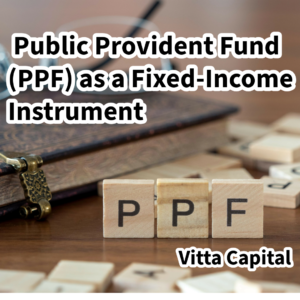An Overview of Public Provident Fund (PPF) as a Fixed-Income Instrument
The Public Provident Fund (PPF) is a popular long-term savings scheme in India, known for its guaranteed returns, tax benefits, and risk-free nature. Established by the government, it’s an excellent choice for conservative investors looking to build wealth steadily over time.
1. What is PPF?
The PPF is a government-backed savings scheme aimed at encouraging long-term investments by individuals.
- Tenure: 15 years, extendable in blocks of 5 years.
- Eligibility: Available to Indian residents. Non-residents are not eligible to open a PPF account.
Example:
If you invest ₹1.5 lakh annually for 15 years at an interest rate of 7.1%, your total corpus at maturity will be approximately ₹40 lakh, thanks to the power of compounding.
2. Features of PPF
A. Guaranteed Returns:
- Interest is set by the government every quarter, ensuring stable returns.
- Current rate: 7.1% per annum (as of Q4 FY 2024-25).
B. Tax-Free Returns:
- Interest earned and maturity amount are completely tax-free.
C. Loan and Withdrawal Facilities:
- Partial withdrawals allowed from the 7th year.
- Loans available from the 3rd to 6th year.
D. Investment Flexibility:
- Minimum annual contribution: ₹500.
- Maximum annual contribution: ₹1.5 lakh.
- Can be paid in a lump sum or up to 12 installments.
3. Benefits of Investing in PPF
A. Risk-Free Investment:
- Government-backed, making it one of the safest investment options.
B. Tax Efficiency:
- Qualifies for tax deduction under Section 80C.
- Interest and maturity are tax-exempt under Section 10(11).
C. Compounding Growth:
- Offers long-term benefits through compounding interest.
D. Diversification:
- Acts as a stable component in a diversified portfolio.
4. Drawbacks of PPF
A. Long Lock-In Period:
- Funds are locked for 15 years, with limited withdrawal options.
B. Interest Rate Risk:
- Rates may be revised quarterly, impacting long-term returns.
C. Contribution Limit:
- Annual investment cap of ₹1.5 lakh may not suffice for high-income individuals.
5. How to Open a PPF Account
A. Online:
- Through net banking or mobile apps of authorized banks.
B. Offline:
- Visit post offices or authorized banks like SBI, ICICI, or HDFC.
Required Documents:
- Proof of Identity: Aadhaar, PAN.
- Proof of Address: Utility bills, Aadhaar.
- Passport-sized photograph.
6. Strategies to Maximize PPF Returns
A. Invest Early in the Financial Year:
- Contribute before the 5th of April each year to maximize interest accrual.
B. Maintain Consistency:
- Invest the maximum allowable amount each year for better compounding.
C. Extend Tenure:
- After 15 years, extend in blocks of 5 years to continue earning tax-free interest.
7. PPF Withdrawal and Loan Rules
A. Partial Withdrawals:
- Allowed after the completion of 6 years.
- Limit: 50% of the balance at the end of the 4th year or the preceding year, whichever is lower.
B. Loans Against PPF:
- Available between the 3rd and 6th year.
- Loan amount: Up to 25% of the balance at the end of the 2nd preceding year.
Example:
If your balance in the 2nd year was ₹2 lakh, you can avail a loan of ₹50,000.
8. Who Should Invest in PPF?
A. Conservative Investors:
- Seeking risk-free and tax-efficient returns.
B. Salaried Individuals:
- To avail tax deductions and build a retirement corpus.
C. Long-Term Planners:
- Ideal for those planning for goals like child education or retirement.
9. Alternatives to PPF
If you want more flexibility or higher returns:
- ELSS (Equity-Linked Savings Schemes): Higher returns with tax benefits but involves market risk.
- National Savings Certificate (NSC): Similar tax benefits with a 5-year lock-in.
- Fixed Deposits: Lower returns but shorter lock-in periods.
Conclusion
The Public Provident Fund is a cornerstone investment for individuals aiming for stability and tax efficiency. While the long lock-in period may seem restrictive, its benefits of risk-free compounding and tax-free returns outweigh the drawbacks. If you’re a patient investor with long-term goals, PPF should be a key part of your financial plan.
🔰Join our Financial Wellness Channel:-https://whatsapp.com/channel/0029VaDegyB3WHTf258XPO1m
For Wealth Management and Financial Planning Connect :- 9560314594
Repost ♻️ and help us to Grow together.
